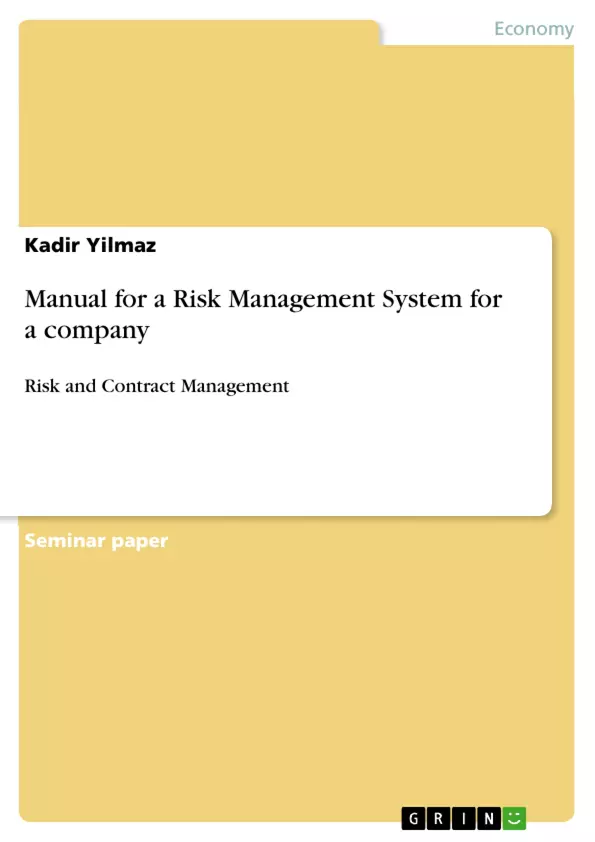In risk management it is important to achieve a healthy balance between risk control and risk volume, meaning that the single projects within a company have to be categorised as processes according to their complexity and size. If this is accomplished it is possible to assess the ongoing and pending business projects without disproportionate effort.
The assessment of control effort will, above all, be made according to the volume which a project has to realise monetarily: A project having a significant sales volume will therefore experience special attention during risk control and in the graded risk control system it will assume a higher position than a project which shows a lower sales volume.
Inhaltsverzeichnis (Table of Contents)
- Introduction
- A. How can we early identify projects that can lead to problems in later phases? Describe a graded approach that considers risks and project size in a balanced way.
- B. How can we recognize early when a project becomes troubled? Describe a graded approach including triggers and thresholds..
- C. What roles and responsibilities do we have to integrate in this process? Who can fulfill these roles (Assign roles to functions)? .
- D. How can the executive management be enabled to provide management support but, on the other hand will be spared with unneeded information and workload?
- E. How can the effect be minimized that different functions have different and unbalanced opinions resulting from their job role?.
- F. Considering the fact, that you cannot reduce/minimize all risks, the management asks you to provide a suggestion to put aside a reserve for the “residual risk”. Following the insurance principle uplifts to all projects shall be calculated.
- G. Develop a strategy on how residual risk uplifts can be spread over all projects in a fair and justified way..
- Literature
- ITM-Checklist
Zielsetzung und Themenschwerpunkte (Objectives and Key Themes)
This manual aims to develop a comprehensive risk management system for a company specializing in commercial projects. The objective is to establish a structured approach for identifying, assessing, and managing risks throughout the project lifecycle. The document explores strategies to balance risk control with project size and complexity, enabling early detection of troubled projects. The key themes addressed in the manual include:- Graded approach to risk management based on project size and complexity
- Early identification and recognition of troubled projects
- Role and responsibility integration in the risk management process
- Effective communication of risk information to executive management
- Addressing potential biases in risk assessment across different functions
Zusammenfassung der Kapitel (Chapter Summaries)
- Introduction: The introduction emphasizes the need for a balanced approach to risk management, categorizing projects based on complexity and size. The company's business is defined, and its revenue and project volume are highlighted.
- A. How can we early identify projects that can lead to problems in later phases? Describe a graded approach that considers risks and project size in a balanced way.: This chapter focuses on developing a graded approach for identifying risky projects. It explains how projects are categorized based on complexity (complex, average, and less complex) and proposes risk assessment methods tailored to each category.
- B. How can we recognize early when a project becomes troubled? Describe a graded approach including triggers and thresholds..: This chapter delves into early recognition of troubled projects. It discusses the implementation of triggers and thresholds within the risk management system to proactively identify potential problems.
- C. What roles and responsibilities do we have to integrate in this process? Who can fulfill these roles (Assign roles to functions)? .: This chapter explores the roles and responsibilities involved in the risk management process. It focuses on identifying key stakeholders and assigning roles to different functions within the company.
- D. How can the executive management be enabled to provide management support but, on the other hand will be spared with unneeded information and workload?: This chapter discusses the importance of effectively communicating risk information to executive management. It aims to develop strategies that provide the necessary support while avoiding information overload.
- E. How can the effect be minimized that different functions have different and unbalanced opinions resulting from their job role?.: This chapter addresses the challenge of potential bias in risk assessments across different functional departments. It aims to develop mechanisms to minimize the impact of differing perspectives.
- F. Considering the fact, that you cannot reduce/minimize all risks, the management asks you to provide a suggestion to put aside a reserve for the “residual risk”. Following the insurance principle uplifts to all projects shall be calculated.: This chapter focuses on managing residual risks. It explores methods for calculating and allocating reserves for potential risks that cannot be fully mitigated.
- G. Develop a strategy on how residual risk uplifts can be spread over all projects in a fair and justified way..: This chapter addresses the allocation of residual risk uplifts across different projects. It aims to develop a strategy that ensures fairness and justification in distributing these costs.
Schlüsselwörter (Keywords)
The core focus of this manual lies in establishing a robust risk management system for commercial projects. Key concepts include: risk assessment, project complexity, graded approach, early identification, troubled projects, role allocation, communication strategies, risk mitigation, residual risks, and fair distribution of uplifts. This manual provides practical insights and strategies for effectively managing risks within a company, promoting project success and sustainable profitability.- Quote paper
- Dr. Kadir Yilmaz (Author), 2009, Manual for a Risk Management System for a company, Munich, GRIN Verlag, https://www.grin.com/document/135949



